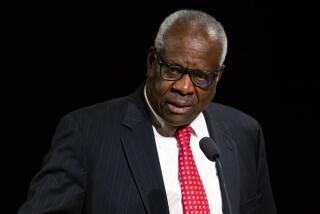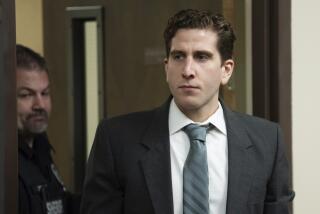Smith vs. Courtroom TV : No one advocates barring print reporters. Why discriminate against television?
Some of the media have hurt their cause by whipping themselves into a disgusting frenzy over the alleged behavior of Paul Reubens, alias Pee-wee Herman. Nevertheless, arguments against televising the William Kennedy Smith trial--which promises to be one of the most sensational court cases of the decade--are almost too ridiculous to bother rebutting.
Almost!
CNN and especially the new Courtroom Television Network both hope to provide wide coverage of Smith’s Florida rape trial, which has been postponed indefinitely by a judge in West Palm Beach in hopes of creating a sort of cooling-down period.
Although Florida is one of 45 states that allows cameras inside courtrooms (California is another), Smith’s lawyers have asked Judge Mary E. Lupo to bar TV on grounds that cameras would swell the proceedings into a “sensationalized Hollywood-style mockery of the justice system.”
Their words mock reality.
You don’t have to look far to find overwrought, predatory media reporting that would appear to validate their fears of increased “carnival-like” coverage. It ranges from the McMartin case here to the frequently leering, snickering stories about Reubens--whom many in the media have symbolically convicted of indecent exposure even though he denies the charge--to the stereophonic din of irresponsible coverage surrounding Smith (a nephew of Sen. Edward M. Kennedy, D-Mass.), who has pleaded not guilty to charges of raping a 29-year-old Florida woman.
All of which has little if any bearing on the issue at hand.
The media circus outside the courtroom--plus hawking of T-shirts with crude depictions of Sen. Kennedy outside the Florida courthouse--will continue, regardless. When it comes to cameras inside the courtroom, however, the arguments offered by Smith’s attorneys are ones long-ago discredited in Florida--which has liberally allowed televised trials since 1979--and other states.
One of the arguments is that the presence of TV transforms participants--witnesses, lawyers, judge and even the jury--into actors performing for the camera. However, there’s just no evidence to support the claim that people inside the courtroom automatically turn on when the red light turns on. And since when, moreover, do trial attorneys require the presence of a camera to encourage them to vamp when they’re trying to impress a jury?
Similar anti-TV protests--since quieted--were heard from those opposing C-SPAN’s congressional telecasts, which have tended to be about as melodramatic as a budget hearing.
Fears of TV’s influence would be justified if cameras in courtrooms were as intrusive as cameras frequently are in newscasts and tabloid and “reality” shows, altering behavior by becoming a close-up participant instead of merely a long-range observer. In contrast, the single camera in the Smith courtroom would be a minicam mounted on a stand at the rear of the room. Unobtrusive. Out of the way. Observing from afar.
America’s fascination with trials--or what it thinks are trials--is epitomized by the popularity of Perry Mason and other fictional courtroom wizards. But these super-heroes, and even “reality” shows purporting to show actual court cases, distort truth by tailoring it to the needs of TV. Actual telecasts of even sensational criminal trials, on the other hand, have at least the potential to educate viewers about a process few of them will ever encounter in person.
CNN, which has been televising significant portions of sensational trials since 1982 without incident, would cover the opening of the Smith trial and return intermittently depending on what was happening. Courtroom Television Network plans no change in its usual format of virtual gavel-to-gavel coverage, and would also provide pool coverage for the rest of TV.
Oh, yes, the rest of TV, especially the media house flies who feed on smelly garbage and the gang of exploiting voyeurs who can’t resist lighting the world in neon. They don’t need real courtroom testimony to make a juicy story when they can fake it.
But inevitably, opponents of courtroom cameras note, even the most responsible newscasts will air sound bites of only the most titillating testimony, resulting in distorted coverage that is good television but bad journalism. However, that charge is just as applicable to print reporters, who have no space to regurgitate entire trial transcripts, after all, but instead risk taking things out of context each time they decide about what to include and omit.
No one advocates barring print reporters from courtrooms. Why discriminate against TV?
As camcorders continue their revolutionary expansion into all areas of our lives, increasing the likelihood even of neighbors electronically spying on each other through bedroom windows, there’s a natural desire to roll back time by conserving little pockets of privacy beyond the lens of the camera.
Trials are not private, however. Cameras or not, they already are open to the public, so the issue is not whether there should be an audience for the Smith trial, but whether TV should be allowed to enlarge it.
“The way to get this story out straight and clear and honorably and true is for the public to have more good solid information, not less,” Floyd Abrams, a prominent First Amendment attorney representing Courtroom Television Network, argued this week before Judge Lupo.
Beyond such platitudes there is a simpler truth: TV coverage of trials is allowed under Florida law, and there is no reason to make an exception with William Kennedy Smith.
More to Read
The biggest entertainment stories
Get our big stories about Hollywood, film, television, music, arts, culture and more right in your inbox as soon as they publish.
You may occasionally receive promotional content from the Los Angeles Times.










